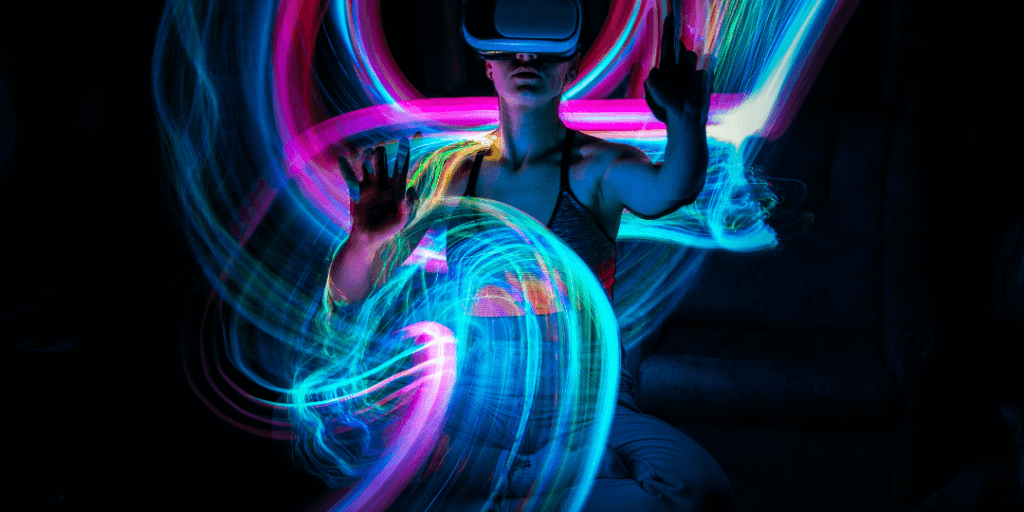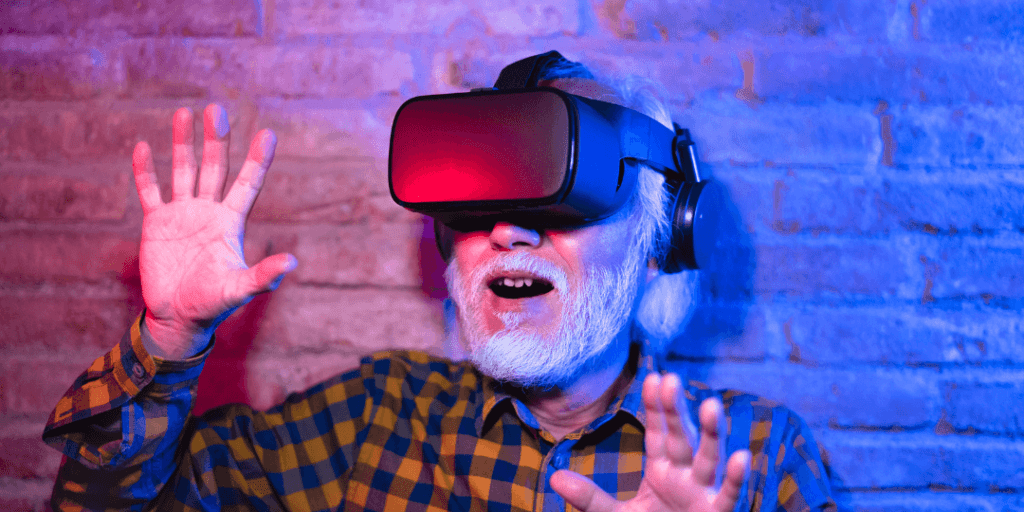
A recent article in Forbes suggests that the metaverse will radically transform content creation by helping creators make more interactive and immersive experiences, thanks mostly in part to advancements in VR and AR.
The article says, “You can imagine a not-too-distant future where creators are tasked with not only producing traditional two-dimensional content that is rather passively consumed, but also creating the means through which users interact with content.”
Meta, the company formerly known as Facebook, is betting the house on this being the case, but is the content marketing industry?
With this in mind, we asked some of our members a few questions on their thoughts and experiences with the metaverse and whether it is just a fad or indeed a future content marketing trend.
Meet this month’s Pulse contributors

Haifa Barbari, Dialect, Inc.
Haifa is an award-winning strategic lead with 17 years of global experience in building brands, and future proofing business, having headed up Strategy with agencies like Saatchi & Saatchi. As Dialect’s EVP of Integrated Strategy & Creative Products, Haifa is at the helm of leading strategy on a global basis and developing strategic offerings for the Web3 space. Passionate about holistic wellbeing, Haifa developed a self-coaching app: Be What Matters, to help people improve their lifestyle and relationships.
Gracie Page-Fozzati, SJR
Gracie is on a mission to help the creative industries use tech to serve humans, rather than the other way around. As Managing Director of Technology at SJR she applies this approach to building content that matters to customers. Gracie sits on WPP’s Innovation Council, is a founding member of the global WPP Creative Technology Community, and has served on the British Interactive Media Association and Snapchat Creative councils. Her ideas have appeared in The Wall Street Journal, The Times, AdobeMAX, TheNextWeb,The Drum, Glamour, Campaign, and more.


Brian Bowen, Pace Communications
Brian is a storyteller, world traveler, street-art collector, marketing disrupter, technology evangelist and head of visual innovation at Pace. Brian is at his best when he’s executing creative ideas across a variety of platforms and technologies; he loves bringing ideas into existence. Prior to joining Pace, Brian cut his digital teeth working at Barefoot Proximity, leading digital video and branded entertainment. Before entering the world of content marketing, he was one of the founders of a nonprofit that brings music education to underprivileged children around the world.
Kathryn Strachan, Copy House
Kathryn launched Copy House in April 2019 after working in-house at digital agencies and successfully running a freelance copywriting business. Her copywriting business quickly transformed into a content marketing agency with global clients including Klarna, Travelex, Cigna and Lloyds Bank.


Neil Marion, Pace Communications
Neil is a seasoned member of the Pace team, with over a decade leading Pace’s creatives to spearhead successful brand campaigns for client partners. His love for the outdoors led him to instruct kayaking and spelunking at Boy Scout camp when he was a kid. He continued his outdoor adventure at Appalachian State, where he mountain biked every day after class. His brand experience includes work for Verizon, Walmart, Four Seasons Hotels and Resorts, Lowe’s Home Improvement, Honda, Acura, AAA, Ekornes Furniture, WonderBra, DKNY, Wrangler and Syngenta.
1. Do you see the metaverse remaining niche or will it develop enough use cases to become a mainstream channel of content creation and immersion?
When it comes to the long term prospects of the metaverse, our respondents believe it is here to stay, though it may take some time to fully develop.
Haifa Barbari, EVP Strategy at Dialect Inc. said, “The metaverse already exists and there is more than one. They are 3D virtual worlds where experiences and gaming have always been at the forefront. The idea of the metaverse is fast becoming more established with a mass commercial interest to make it more accessible to the average consumer and part of our every-day reality.
“The technology and experience has been there, gaming is ahead and now we, marketers have the opportunity to integrate metaverses with the brand and community experience. While accessibility and interoperability might be key challenges at the moment, there is commercial interest in metaverses and we are seeing early signs of brands and technology companies exploring device upgrades and how to partner (or not). In time, virtual worlds will become more accessible and the tools more affordable. We can expect to see a staged revolution of change over the next 10 years.”
Brian Bowen, VP of Visual Innovation and Executive Producer at Pace agrees that gaming will be the industry that advances the metaverse first.
“The metaverse as a construct is still in its infancy, so we’ve only seen glimpses of what it can become. We can expect to see gaming and training/education as primary uses for some time yet, but meaningful use cases will converge and overlap until the metaverse is truly realized.
“For most brands, the entry point to the metaverse will be extended reality (XR), which is a broad term spanning technologies such as virtual reality (VR), augmented reality (AR), and mixed reality (MR). VR is increasingly available, with consumers using existing mobile devices, apps, earbuds and gaming consoles to access virtual experiences.”
Gracie Page-Fozzati, MD of Technology at SJR said, “Today’s metaverse position in the long-arc of maturation and adoption can be likened to the social media landscape of a decade ago and because of this parallel many actors and agencies are treating it as another new social platform – a place for people and businesses to connect around common content. To do so is to misunderstand and grossly under-utilise the power of this new digital space.
“By virtue of the fact these technologies focus on transparency, indelibility, and trustlessness, they can be used to build entirely new business models and value exchanges between businesses and customers, and it’s only once brands realise this and use the tech to its full extent that we’ll see the metaverse move past an odd vision of leg-less avatars and into a powerful digital space that offers humans entirely new ways of doing things.”
Kathryn Strachan, founder of Copy House warned against jumping on the metaverse for its own sake, “I think the metaverse will develop and become a popular marketing channel but I don’t think it will be relevant to all brands and customers. Meaning, brands should only utilise the metaverse to help them build relationships if their target audience is on it, rather than using it for the sake of being on it. My advice is to find out where your audience is and then decide whether you should create content on this platform, just like you would for other marketing channels like LinkedIn and TikTok.”
“With the approach of Web3, early collaborators and adopters who are willing to test and learn in metaverse spaces will become the front runners in content creation.”
Neil Marion
The rise of Web3 will help the adoption of the metaverse according to some of our members.
Gracie said, “The magic of the metaverse is not bringing people together through devices across the miles (a feat we’ve already achieved in much of the world), but rather the web3 technologies which underpin it.
Neil Marion, Executive Creative Director at Pace agrees. “With the approach of Web3, early collaborators and adopters who are willing to test and learn in metaverse spaces will become the front runners in content creation. There’s already demand for audio and video experiences in more virtual settings—take virtual concerts as an example—and we anticipate new forms of immersive content emerging rapidly as the technology becomes more and more mainstream.”
Brian added, “Organizations are also expanding into the metaverse through Web3 addresses, such as www.brand.eth or www.brand.xyz. This is a simple starting point to launch digital crypto/blockchain wallets. Branded Web3 addresses will become the destination needed to sell goods and experiences. Branded digital wallets will link directly to customers’ digital wallets via cross-platform browsers, becoming customers’ passports into all Web3/XR experiences.”

2. Are clients asking for a metaverse strategy and/or are you proposing it to clients and in new biz pitches?
When it comes to client adoption of the metaverse, responses tend to fit in the no adoption category to “metaverse-curious” as Gracie says.
“At this stage our clients are metaverse-curious. We’re lucky enough to work with incredible business leaders who understand the importance of long-term brand building through content, so as an agency we are, to an extent, shielded from a lot of the gimmicky hype that others might deal more frequently. So now it’s really all about education, education, education.
Haifa said some clients are keen not to repeat the past when digital was considered a passing fad and they didn’t invest in it accordingly.
“Brands are recognizing the opportunities of building their presence in the metaverses and need a strategy.”
Haifa Barbari
“Yes. Two things are happening. Reactivity and fear of being caught in the past, echoing how some organizations took too long to start their digital transformation journey, and others are strategically learning from the past only this time, to shape their future. Brands are recognizing the opportunities of building their presence in the metaverses and need a strategy.”
Neil echoed these sentiments, “We’ve had a handful of clients—even in industries that are conservative about adopting new technologies—ask us about Metaverse strategy already, and we’ve been proactively discussing metaverse marketing in our client communications since the start of the year. Some of our clients are already looking closely at training and safety programs built on metaverse platforms as well.
Kathryn shared a different perspective saying that the clients they work with and the industry they’re involved in are slow to adopt to ‘Web2’ technologies so they intend to prioritise that first.
“Although we recently launched a social media marketing service, this service is predominantly focused on building virtual relationships on popular B2B platforms such as LinkedIn and Twitter. Depending on the growth and demand of this service, we may branch into other platforms like the metaverse. However, most technology and FinTech brands that we work with either have no social media presence or very little. Therefore we want to focus on platforms that we know their B2B audience can be found on.”
3. What kind of content will become suitable for the metaverse and will it change typical forms of the content creation process?
We wanted to understand what kind of content would fit into the metaverse and how that might impact the content creation process. Our answers are varied but all agreed that metaverse content will be a mix of the old, new and the experiential.
Haifa said, “Content in the metaverse should be experiential. Think Immersive, 3D, VR and AR integration that brings value to the person consuming it in the world they are immersing themselves in. And enter your brand into the metaverse purposefully, not just for the sake of being there. You have your brand reputation at stake.”

Adding to Haifa’s comment about immersive content, Kathryn agreed but also noted that ‘regular’ content will be needed too.
“Video and audio content will be most suitable for the metaverse. This is due to its ability to create immersive experiences with the use of AI, AR and other technologies. However, to truly create immersive experiences, written content will also be needed. For example, brands can create virtual libraries where you can immerse yourself in a book in another universe and scriptwriting will be essential too. However, video and audio will dominate this market.”
Neil said content marketers will have to be brave when creating content for the metaverse while meeting people on their own terms inside it.
“Audiences are already using virtual technologies to consume video and audio together from afar, such as how people connected to watch movies together while isolating during COVID-19 lockdowns. We also have more than two decades of online social gaming, and the momentum for that industry is only getting stronger. Based on these trends, the metaverse will open content marketing up to new forms of collaborative storytelling, where audiences interact with and add to brand messaging, stories and experiences. It will take brave marketers to allow consumers to help tell their story.”
“The metaverse will reshape our creativity as well. For example, we will shift from telling stories to living them collaboratively. Story living in the metaverse is about content creators developing the high-level storylines that outside audiences can then unfold for their themselves, with multiple entry points and the freedom to explore and experience the content at will.”
“We have an opportunity here to leverage a different type of technology to re-think how businesses deliver value to their prospects. It would be a missed opportunity to think purely skeuomorphically, that is “how can I make content I already create fit into the metaverse?”
Gracie Page-Fozzati
Gracie pointed out that there is no one metaverse but rather multiple metaverses that content marketers will have to consider.
“The metaverse has surged as a convenient way to capture a variety of ideas under one umbrella term, but it’s important to note there is no single metaverse. Metaverses are being built by a number of actors — hot-topic examples include Meta’s metaverse, Decentraland, and Lego and Epic Games’ recently announced metaverse built specifically for young audiences. These various metaverses won’t necessarily inter-operate, and each may give rise to their own content formats and possibilities for dialoguing with the everywoman, dependent on how technologies like non-fungible tokens (NFTs), smart contracts, and blockchain ledgers are used.”






